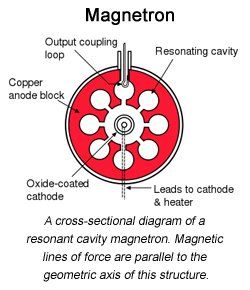Magnetrons
The cavity magnetron is a high-powered vacuum tube that generates microwaves using the interaction of a stream of electrons with a magnetic field. The compact cavity magnetron tube drastically reduces the size of radar sets so that they can be installed in anti-submarine aircraft and escort ships.
All cavity magnetrons consist of a hot cathode with a high (continuous or pulsed) negative potential created by a high-voltage, direct-current power supply. The cathode is built into the center of an evacuated, lobed, circular chamber. A magnetic field parallel to the filament is imposed by a permanent magnet. The magnetic field causes the electrons, attracted to the (relatively) positive outer part of the chamber, to spiral outward in a circular path, a consequence of the Lorentz force. Spaced around the rim of the chamber are cylindrical cavities. The cavities are open along their length and connect the common cavity space. As electrons sweep past these openings, they induce a resonant, high-frequency radio field in the cavity, which in turn causes the electrons to bunch into groups. A portion of the field is extracted with a short antenna that is connected to a waveguide (a metal tube usually of rectangular cross section). The waveguide directs the extracted RF energy to the load.
The sizes of the cavities determine the resonant frequency, and thereby the frequency of emitted microwaves. The operating frequency varies with changes in load impedance, with changes in the supply current, and with the temperature of the tube. This is not a problem in uses such as some forms of radar where the receiver can be synchronized with an imprecise magnetron frequency.
References
- T. K. Ishii, The Electronics Handbook, 2nd ed., pages 506-509. (2005).
- Ma, L. "3D Computer Modeling of Magnetrons." University of London Ph.D. Thesis. December 2004.
- James E. Brittain, "The magnetron and the beginnings of the microwave age," Physics Today, vol. 38, pages 60-67 (1985).
- Hidetsugu Yagi, "Beam transmission of ultra-short waves," Proceedings of the Institute of Radio Engineers, vol. 16, no. 6, pages 715-741 (1928).
(Extracted from Wikipedia.com.)

